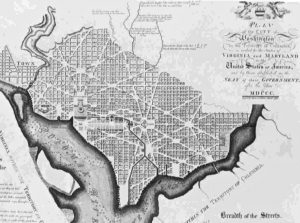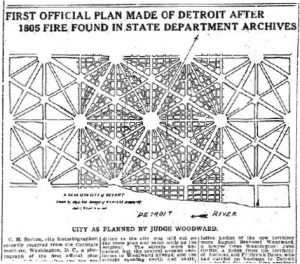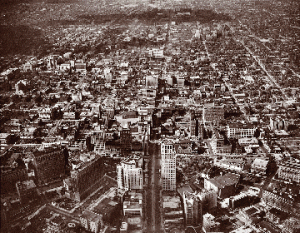JUSTICE AUGUSTUS BREEVORT WOODWARD (1774‑1827) AND HIS SPIDERY PLAN FOR DETROIT
JUSTICE AUGUSTUS BREEVORT WOODWARD (1774‑1827) AND HIS SPIDERY PLAN FOR DETROIT

Complexity in the plan of Detroit
The wind was violent around 9 AM Tuesday, June 11, 1805, in the frontier outpost of Detroit. As a routine bugle sounded from the fort, many of the 600 townspeople were fixing breakfast. John Harvey, the town baker, had run out of flour, so he and his hired-hand planned to drive to James May’s mill for a fresh supply. Before hitching horse to cart, one of them tapped his pipe to discharge the ashes, and a crimson ember sailed off and ignited a pile of hay. Flames raced from one little log house to the next. A bucket brigade formed at the nearby Detroit River, and an old British fire engine was moved toward the conflagration, but the scale of the inferno was overwhelming. Two hours later, nothing in the town existed other than charred chimneys and a riverside warehouse on Wayne Street. The fire also consumed the fort and barracks. Fortunately, no one died. For immediate shelter, the townspeople tried to cram into the few houses that directly bordered the river, but the need far exceeded the available sanctuary. Within days, a haphazard shantytown began to sprout amid the ashes where old Detroit once stood. The town was desperately in need of a savior…a savior with a vision.
Born in New York City in 1774, Augustus Breevort Woodward entered Columbia College at fifteen. He was keenly interested in science. Around 1795 when he was 21, Woodward moved to Rockbridge County, Virginia, to teach and read law. “While in Rockbridge County, “…he was received in Monticello and admitted to Thomas Jefferson’s intimate circle.” Jefferson was 30 years older than his new friend. Woodward noted that on the first meeting, Jefferson treated him with a lack of warmth, “almost like a stranger,” but over time, they became close friends. “Many a day, he and Woodward would sit before a warm fire discussing their theories of government and sharing books that they had read – both were voracious readers.” It is quite likely they discussed the art of city planning, Jefferson expressing his “undeviating advocacy” for a simple gridiron layout, such as used by William Penn in Philadelphia, where Jefferson had frequently traveled. To that engaging subject, Jefferson brought his “astonishingly fertile mind in originality, logic, and interest.” Woodward was no intellectual slouch, either. In 1801, when he was just twenty-seven, Woodward revealed the scope of his interests when he published a booklet entitled Considerations on the Substance of the Sun.

Penn’s Plan for Philadelphia
In 1797, not long after Jefferson became Vice President of the United States, Woodward moved to Alexandria. Four years later, he became the first attorney to set up practice in that city: but even though his writing skills were superb, he barely made a living. Stooped over at 6′ -3,” and with a sallow complexion framing his exceptionally long nose, he was not an attractive sight. Cartoons of him were not kindly. Although a portrait of him showed him in a green topcoat, he reportedly always dressed in a nut-brown suit with a buff vest, out of which exploded an immense mass of ruffles. The dapper young attorney liked his hair trimmed neatly and slicked down.

In addition to Thomas Jefferson, Woodward also became close friends in Washington with Jefferson’s friend, the brilliant and erratic Pierre Charles L’Enfant, a French engineer who came from France to fight in the Revolutionary war. L’Enfant was hired to design the new capital of the country for which he had recently fought. He expansively modeled Washington on Versailles, a vast royal palatial estate north of Paris. The master landscape architect Andre Le Notre designed Versailles, which consisted of radial cart ways and highly geometric parterres. Jefferson made clear to President George Washington and others that he opposed a Baroque scheme for the new capital and, in fact, urged L’Enfant to work with an orthogonal street scheme, known as a checkerboard scheme. However, sometime before 1801, Jefferson became disenchanted with the wallpaper monotony of gridiron street schemes and their frequent absence of open spaces. However, Woodward saw the potential future beauty and stateliness of L’Enfant’s plan for Washington. His heart warmed as he imagined the broad diagonally-oriented avenues, magnificent vistas, and the civically oriented open spaces.

In March 1805, now-President Thomas Jefferson appointed Woodward Judge for the Territory of Michigan. Woodward packed his belongings and arrived in Detroit, just two weeks after the fire had destroyed the town. In less than a month, Governor Hull appointed Woodward, “a committee of one” to develop a street plan for Detroit. Was Woodward the savior the cindery little town so desperately needed?
But why did the Governor ask the eccentric but erudite Woodward to devise a scheme? Why would this near-friendless, stingy, slovenly, impoverished, and hardened bachelor (who routinely slept in his dirty office) be the right man to raise Detroit from its ashes into a future condition of glory? Could it have been his force of character, his visionary talents, or both? Was it possible that this odd fellow who always kept a glass of brandy on the bench before him, and who smoked his pipe and downed a pint of whiskey after dinner, be the right man for the job?
The citizens of Detroit were living in temporary shacks and naturally wanted to rebuild as soon as possible. But Woodward convinced them to be patient while he drew his plan and surveyed the land to establish the individual property lines. Woodward’s proposed street plan with its complex geometry was not easy to plot out. The process took one and a half years, during which time the citizens grew increasingly restless to get on with their lives. Some ignored the rules and began building permanent homes, disregarding Woodward’s scheme.
In his beautifully researched book THE MAKING OF URBAN AMERICAN, John Reps provides an excellent analysis of the plan to raise the town out of the ashes. “Woodward’s Detroit was no mirror copy of the Washington plan, to which it has been frequently compared. It is true that both plans were on a grand scale, both utilized diagonal streets, and both made frequent use of symmetrical open spaces as terminal features for broad avenues. The underlying concepts, however, were different.
“Washington as planned by Major L’ Enfant combined two types of street systems. The basic pattern was a grid of streets with right-angle intersections. Superimposed on this system was another, consisting of diagonal avenues directly connecting the principal points of the new city. Aside from certain visual defects resulting from the rolling terrain, there were other shortcomings in the Washington plan. Acute-angle street intersections, irregular shaped lots, and unusable remnants of land all owe their origins to L’Enfant’s attempt to combine rather than integrate two different street systems.
“In the plan of Detroit these faults were largely overcome. A single integrated pattern was used, a pattern as suitable to the level topography as any other abstract system of land subdivision, including the gridiron. Unlike the typical block plan so familiar throughout most of America, the plan of Detroit, like that of Washington, provided for streets of different widths. Principal avenues were laid out north-south and east–west with a with of 200 feet. Other main streets were planted 120 feet wide, while minor streets were given the generous with of 60 feet.

“Two units of open space were employed at regular intervals. At the intersection of 12 avenues Woodward designed a “Grand Circus” of 5-1/2 acres. To avoid sharp points at these intersections, he cut back the blocks to provide for lots of more normal shape. Smaller rectangular open spaces at every intersection of six avenues were treated in similar fashion.
“The central portion of each triangular section of land was left open. An act of the Governor and Judges in May 1807 makes the reason clear.
“”…The internal space of ground, in the middle of every section, shall be reserved for public wells and pumps, for markets, for public schools, for houses for the reception of engines or other articles for the extinction of fires, and the preservation of the property of the inhabitants, for houses for the meeting of religious, moral, literary, or political societies, other useful associations and generally, for such purposes of utility or ornament, as the city council of Detroit may… direct….”” When a new plan was prepared, “The citizens of Detroit appeared much less interested in Woodward’s vision of a great metropolis than in obtaining clear and immediate title to property in the new town… Woodward attacked the new proposal as illegal on a number of grounds.… He envisaged Detroit as the great metropolis it has since become: “Nature has destined the city of Detroit to be a great interior emporium, equal if not superior to any other on the surface of the of the globe. “

Author Richard Sands writes, “Although [Woodward’s] plan was abandoned after 11 years, some of its most significant features had already been implemented…and you can see L’Enfant’s imprint.”
“What would Detroit be like if Woodward’s vision had been followed? Would it have been a workable plan for a modern city? Perhaps the plan with its intricate triangular pattern was too abstract and complicated. Modern planners might shudder at the maze of diagonal streets and confusing intersections. One thing is certain. If Detroit’s growth through the years had been guided by men approaching Woodward in vision, determination, and wisdom, and with the additional ability of intelligent compromise and flexibility which he perhaps lacked, Detroit’s planners of today would be facing an easier and more enviable task of adjusting the pattern of a complicated metropolis to meet the demands of contemporary life.”

After Woodward retired, he focused his interests once again on science and was one of the first in the nation to recognize the coming of the scientific age. He wondered about the sun, electricity, light, heat, and magnetism. Vivian M. Bauch, in a 1999 article in the Detroit News described him this way, “Judge Woodward was quite a character. Controversies about his judicial opinions caused one contemporary to describe him as “A wild theorist fit only to extract sunbeams from cucumbers!” While difficult at times, Judge Woodward stood up against slavery and appeared to be active in the Underground Railroad. He did, in fact, bring to the ashes of Detroit what was necessary to be its savior, but the everyday pressures of the moment unraveled his visionary scheme.

In city planning, the gridiron makes excellent sense. It is easy for drivers to navigate, easy to lay out, and it is easy city plan in which to construct and repair streets and utilities. The properties in a gridiron plan, being rectangular, lend themselves to building construction, which more often than not has been based on right angles. City plans with diagonal street schemes provide the opposite; they can make life difficult. Acute angles, in particular, when added to a gridiron plan, create challenging conditions for travelers and builders. Sometimes they create opportunities during the Age of Diagonality. Consider I. M Pei’s East Wing addition to the National Gallery of Art in Washington DC, built on what was probably once deemed an impossible-to-build-on triangular lot. Cities are different from gardens where, as in Versailles, diagonals offer majesty, focus, and variety. But diagonals in a city plan do add visual drama, they direct attention toward important sites, and they provide experiential variety. In Detroit, Woodward created a very nuanced scheme that involves rectangles and rotated rectangles, hexagons, and triangles, all of which emanate from a pattern of radials. Before the age of GPS navigation systems, this plan might have been a nightmare to drive through but an exquisite pattern to behold from an airplane. Diagonality in city planning must be employed judiciously and with great skill, avoiding the seduction that derives from seeing only the geometric complexity of the layout. The end product must be a livable city that can expand organically over time.
A writer once remarked that “Detroit was modeled after Washington, Washington after Versailles, and Versailles after a cobweb.”
Appreciation to:
•The Detroit Historical Society
•Richard H. Sands Emeritus Professor of Physics, University of Michigan (Judge Augustus Woodward – A freemason and Founder of the First Complete Public Education System in America)
•Michigan Supreme Court Historical Society. The Early Bench and Bar of Detroit from 1805 to the End of 1850
•John W. Reps “The Making of Urban America: A History of City Planning in the United States”
I took the liberty to freely organize the above excerpts to satisfy the goals of this article and to do justice to the complex character of Judge Woodward. Any resulting confusion or errors are mine alone. Joel Levinson